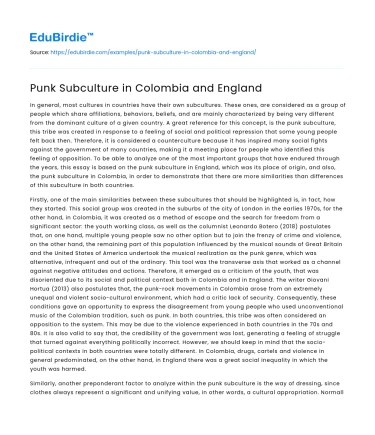In general, most cultures in countries have their own subcultures. These ones, are considered as a group of people which share affiliations, behaviors, beliefs, and are mainly characterized by being very different from the dominant culture of a given country. A great reference for this concept, is the punk subculture, this tribe was created in response to a feeling of social and political repression that some young people felt back then. Therefore, it is considered a counterculture because it has inspired many social fights against the government of many countries, making it a meeting place for people who identified this feeling of opposition. To be able to analyze one of the most important groups that have endured through the years, this essay is based on the punk subculture in England, which was its place of origin, and also, the punk subculture in Colombia, in order to demonstrate that there are more similarities than differences of this subculture in both countries.
Firstly, one of the main similarities between these subcultures that should be highlighted is, in fact, how they started. This social group was created in the suburbs of the city of London in the earlies 1970s, for the other hand, in Colombia, it was created as a method of escape and the search for freedom from a significant sector: the youth working class, as well as the columnist Leonardo Botero (2018) postulates that, on one hand, multiple young people saw no other option but to join the frenzy of crime and violence, on the other hand, the remaining part of this population influenced by the musical sounds of Great Britain and the United States of America undertook the musical realization as the punk genre, which was alternative, infrequent and out of the ordinary. This tool was the transverse axis that worked as a channel against negative attitudes and actions. Therefore, it emerged as a criticism of the youth, that was disoriented due to its social and political context both in Colombia and in England. The writer Giovani Hortua (2013) also postulates that, the punk-rock movements in Colombia arose from an extremely unequal and violent socio-cultural environment, which had a critic lack of security. Consequently, these conditions gave an opportunity to express the disagreement from young people who used unconventional music of the Colombian tradition, such as punk. In both countries, this tribe was often considered an opposition to the system. This may be due to the violence experienced in both countries in the 70s and 80s. It is also valid to say that, the credibility of the government was lost, generating a feeling of struggle that turned against everything politically incorrect. However, we should keep in mind that the socio-political contexts in both countries were totally different. In Colombia, drugs, cartels and violence in general predominated, on the other hand, in England there was a great social inequality in which the youth was harmed.
Similarly, another preponderant factor to analyze within the punk subculture is the way of dressing, since clothes always represent a significant and unifying value, in other words, a cultural appropriation. Normally, their outfits differ from the other subcultures around the world because they are atypical. According to St. James Encyclopedia of Popular (2019), the punks have always transgressed the typical and traditional dresses, therefore, they generated a stir with a style of torn clothes and dyed hair or extremely short haircuts. In this way, the punk style created an image and representation based on a strong and worn-out society and an anti-fashion sense that manifested a proposal against current trends back then. However, in both cases, both in England and in Colombia clothing trends are similar in some aspects, such as second-hand clothing or just jackets, but in England they tend to be original. In the other hand, in most Colombian punk groups the intention is to copy the trends of other countries, however, this predisposition is linked to the city, for example, the punk style in Bogota is not the same as in Barranquilla, mainly because of high temperatures.
On the other hand, it is also important to emphasize what type of music does this subculture listen to, especially, in this community. Punk rock and other sub-genres, such as soft punk, rock, hardcore punk, ska punk, are very important. Also, there have been many exhibitors of this type of music and this subculture over the time, for example, in England, the most famous exhibitor is the Sex Pistols band, and on the Colombian side, an important band is IRA. These two bands created songs that express the feeling, struggle and anti-system stories that this community went through, described with strong and hurtful words. However, it is also important to highlight that the lyrics of the songs in both countries have many differences, in Colombia, the lyrics overflow words with aggressive and violent denominations. In contrast, in England, the words are more acceptable and they have a lower index of censorship. According to the Encyclopedia of James Popular of Popular (2019), punk people give a radical turn to topics such as romanticism or everyday life, that is, what can commonly be portrayed in a conventional song. In fact, this community is particularly anti-romantic with their feelings, and we can notice that especially in punk songs which show us a social and radical critique of society, generating hostilities against the government and the regime with a simple, fast and mostly aggressive rhythm.
In conclusion, the punk subculture was created through difficult socio-political events, both in Colombia and in England, it was the escape route for many young people who wanted to express everything they felt and the situations. Factors such as the type of costumes, the conception of reality, as well as the implicit elements in the lyrics of the songs, are critical components to analyze this group in each country because it presents multiple differences due to the specific context.






 Stuck on your essay?
Stuck on your essay?

